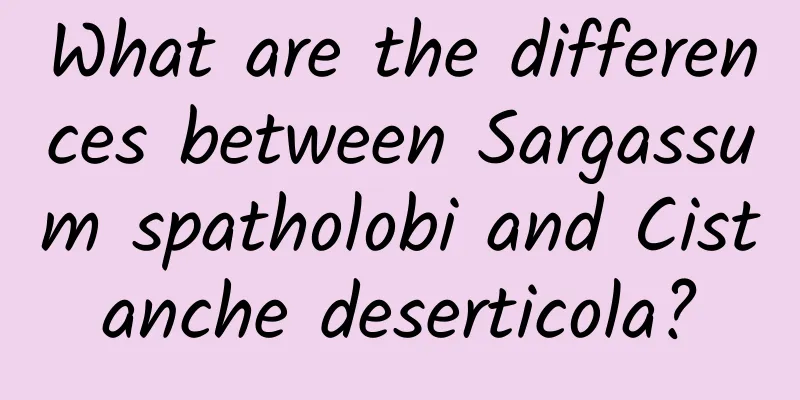What are the differences between Sargassum spatholobi and Cistanche deserticola?

|
Blood vine is an important medicinal plant in life. Its medicinal value is quite high and it is very effective in treating difficult and complicated diseases of the human body. There are many types of blood vine. Among them, Big Blood vine and Millettia reticulata are two more famous ones. However, the two types of blood vine have great differences in medical effects and appearance. Let’s take a look at the differences between Big Blood vine and Millettia reticulata. I hope you can understand it. Since both Sargassum spatholobi and Millettia reticulata are vine-based medicinal materials, reddish-brown blood-like juice will flow out when they are cut, so it is common to mix them in clinical practice. But in fact, the two are two different medicinal materials, which are different from each other in terms of source and function. The key points of identification are as follows: Sargentodendron chinense: It is the vine stem of Sargentodendron chinense of the Akebia family, commonly known as red vine. It is mild in nature, bitter in taste, and enters the large intestine and liver meridians. It has the functions of clearing away heat, detoxifying, promoting blood circulation and dispelling wind. It is mainly used to treat intestinal carbuncle, abdominal pain, amenorrhea, dysmenorrhea, rheumatic pain, and swelling and pain caused by falls. Medicinal material properties: The stem is cylindrical, slightly curved, 30 to 60 cm long and 1 to 3 cm in diameter. The surface is gray-brown and rough, and the outer skin often peels off in scales. The peeled areas are dark reddish-brown, and some have swollen nodes and slightly sunken branch or leaf marks. It is hard, with reddish-brown bark in cross section and six places embedded in the wood. The wood is yellowish white, with many pore-like vessels and rays arranged radially. Slight smell, slightly astringent taste. Millettia reticulata: the vine stem of the leguminosae plant Millettia reticulata. It is warm in nature, bitter and sweet in flavor, and enters the liver and kidney meridians. It has the functions of nourishing blood, activating blood circulation and unblocking meridians. It is mainly used to treat irregular menstruation, blood deficiency and sallow complexion, numbness and paralysis, and rheumatic pain. Medicinal material properties: The stem is oval, oblong or irregularly sliced, 0.3 to 1 cm thick. The cork is gray-brown, some with gray-white spots, and the place where the cork falls off is reddish-brown. The cut surface of the xylem is reddish brown or brown, with numerous vascular pores; the phloem has resinous secretions that are reddish brown to dark brown, arranged alternately with the xylem in 3 to 8 eccentric semicircular rings; the pith is biased to one side. It is hard in texture, has a faint smell and a bitter taste. |
<<: What are the effects and functions of five-spice blood vine?
>>: Which one is better, King Kong vine or Millettia reticulata?
Recommend
Why can’t we see the far side of the moon from Earth? How difficult is it for Chang’e-6 to land on the far side of the moon?
Why can't we see the far side of the moon fro...
The efficacy and function of Sassafras
The Chinese medicinal sassafras tree is a relativ...
The role and efficacy of Polygonum multiflorum
Polygonum multiflorum is a well-known precious me...
China Hernia Day丨Don’t ignore the small matter of “hernia”! Talk about “hernia”
March 7th of every year is "China Hernia Day...
The efficacy and function of dry rock gangue
After thousands of years of sedimentation and acc...
What are the effects of the traditional Chinese medicine Cistanche deserticola
Cistanche has extremely high medicinal value and ...
Zero-waste islands, near-zero-carbon communities…Have you heard of these “green footprints” of China?
Hello everyone, I am Ke Chengwei from Vanke Chari...
The efficacy and function of red head fairy
Red-headed fairy is a very common Chinese medicin...
How to take good care of the elderly at home in autumn?
As the saying goes, "the more autumn rain fa...
What are the effects and contraindications of deer antler?
Deer antler is a relatively precious medicinal ma...
Human genome sequencing has been completed. What does this mean?
It is very interesting for humans to study their ...
The efficacy and function of pomelo flowers
Speaking of pomelo flowers, many people know that...
The efficacy and function of coriander in western Hubei
We know that there are many kinds of Chinese medi...
Interesting story | What is the relationship between Cao Cao’s migraine and stroke?
Cao Cao was a famous politician, military strateg...
Today in Science and Technology History | 1908·7·10 Humans successfully liquefied helium gas for the first time
On July 10, 1908, the discoverer of superconducti...









